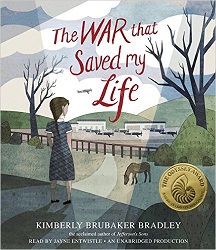
 The War That Saved My Life
The War That Saved My LifeReview posted April 23, 2016.
Listening Library, 2015. 7.5 hours on 6 compact discs.
Starred Review
2016 Newbery Honor Book
2016 Odyssey Award Winner
2016 Schneider Family Award Winner
2016 Sonderbooks Stand-out: #1 Children's Fiction
I always try to listen to the Odyssey Award winner, since it is given to the best children’s or young adult audiobook of the year. This year, the winner was also a Newbery Honor book and a Schneider Family Award winner, so I already knew it was something special. First, I got to listen to Echo, which was also a Newbery Honor book but the only Odyssey Honor audiobook. It was so good, it was hard to imagine an audiobook being chosen above it.
Even with that much build-up, when I listened to The War that Saved my Life, I was not at all disappointed. This was one of the few audiobooks that, when I got to the last CD, I brought the book into the house to finish listening, rather than wait until the morning and my next trip to work. It was way too good to wait!
I should say a word about the narrator, Jayne Entwistle. I’ve listened to other books she’s read, The Scandalous Sisterhood of Prickwillow Place and As Chimney Sweepers Come to Dust. I always enjoy her distinctive voice. Now, I do enjoy almost all English accents, but Jayne Entwistle does an excellent precocious little girl. And she does a fine job making the voices of the various characters distinctive. In this case, she didn’t need to do as many voices as in The Scandalous Sisterhood, and she put just the right character into each of the voices she did portray.
The story in The War that Saved my Life is heart-wrenching. The story is told by Ada Smith. She’s got a club foot, though at the beginning of the book, she doesn’t know that’s what it’s called. She only knows that her foot is disgusting, according to her Mam, and she’s not to let anyone see her. She must stay in their one-room apartment in London.
It’s bearable for Ada when she has her little brother Jamie to watch over. But as Jamie’s getting old enough to go to school, he’s also old enough to start playing outside. Ada’s heart is torn being alone in the apartment. So she decides to teach herself to walk.
Not long after, they learn that London children are going to be evacuated to the country because bombs will be coming from Hitler. Mam hasn’t decided if she’ll send Jamie. Ada asks about herself.
Mam still didn’t look at me. “Course not. They’re sending kids to live with nice people. Who’d want you? Nobody, that’s who. Nice people don’t want to look at that foot.”
“I could stay with nasty people,” I said. “Wouldn’t be any different than living here.”
I saw the slap coming, but didn’t duck fast enough. “None of your sass,” she said. Her mouth twisted into the smile that made my insides clench. “You can’t leave. You never will. You’re stuck here, right here in this room, bombs or no.”
All of that happens in the first two chapters.
But Ada decides then and there that she will leave with Jamie. Her Mam doesn’t know she can walk, and Ada steals Mam’s shoes and sneaks out with Jamie to get there early on the day the children are evacuated.
Once they’re in the country, Ada and Jamie are indeed the last ones picked. The “iron-faced” woman in charge takes them to the home of Susan Smith. Susan doesn’t want children. She is mourning the loss of her “very dear friend” Becky, who lived with her and kept horses.
There’s still a pony named Butter out in the field, and Ada is fascinated with it. The story that follows shows us clearly how Ada’s life is saved. Susan’s and Jamie’s lives are changed along the way.
Words can’t adequately describe this book and how brilliantly the story is woven. The two short chapters at the beginning prepare us for how deprived Ada is, but it’s more fully revealed as she comes out of the room and copes with the country.
Here’s a bit from their ride on the train:
The buildings ended and suddenly there was green. Green everywhere. Bright, vibrant, astonishing green, floating into the air toward the blue, blue sky. I stared, mesmerized. “What’s that?”
“Grass,” Jamie said.
“Grass?” He knew about this green? There wasn’t any grass on our lane, nor nothing like it that I’d ever seen. I knew green from clothing or cabbages, not from fields.
Jamie nodded. “It’s on the ground. Spikey stuff, but soft, not prickly. There’s grass in the churchyard. Round the headstones. And trees, like that over there.” He pointed out the window.
Trees were tall and thin, like stalks of celery, only giant-sized. Bursts of green on top. “When were you in a churchyard?” I asked. What’s a churchyard? I might have asked next. There was no end to the things I didn’t know.
Later on, it seems utterly realistic that, rather than being grateful, Ada gets frustrated and annoyed with all the things Susan tells her, full of words she doesn’t know. When Susan makes a beautiful dress for Ada for Christmas, she has a complete meltdown, unable to feel that something so nice can be for her.
But most of the book is filled with little victories. Ada learns to use crutches. She learns to care for Butter. She learns how to go among people and makes friends.
And the backdrop of all this is the war, which does come even to the countryside. And the looming question of what will happen when Ada has to go back?
This is a beautiful book. Even though I listened to it, I’m going to keep my Advance Reader Copy, because I am going to want to treasure Ada’s story again. I’m sure I’ll notice subtle emotional cues I didn’t catch the first time.
How can I tell children about this wonderful book? I may decide to play up the bombs and spies (Yes, they are both in there). This is ultimately a book about the value found in every person and how love can save your life.
